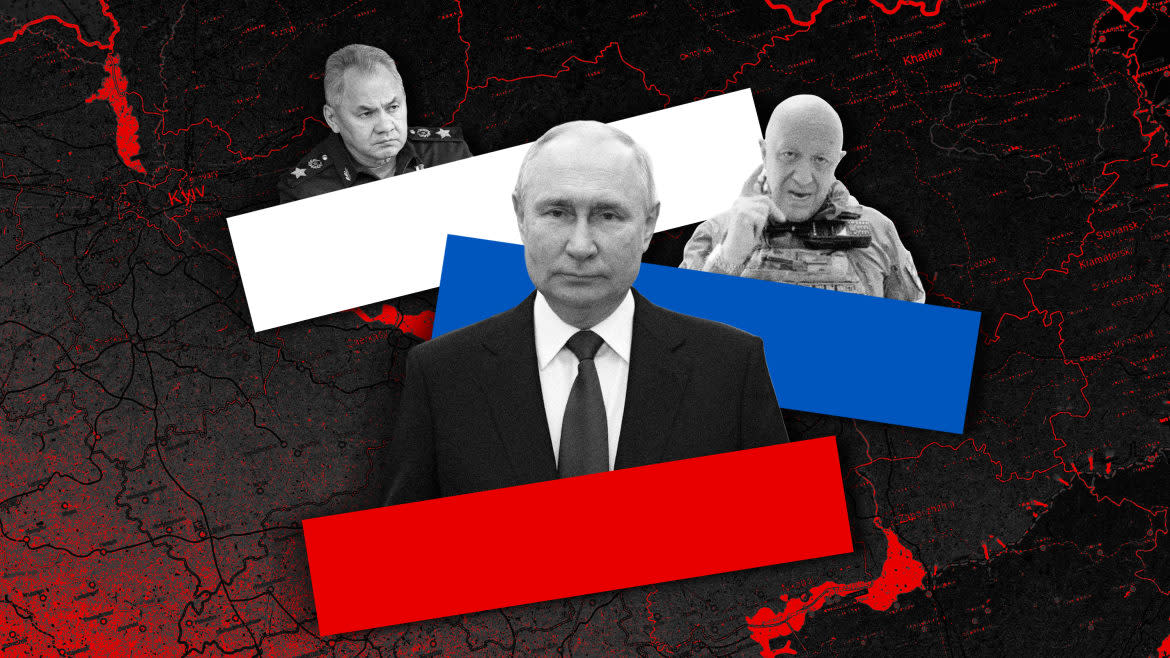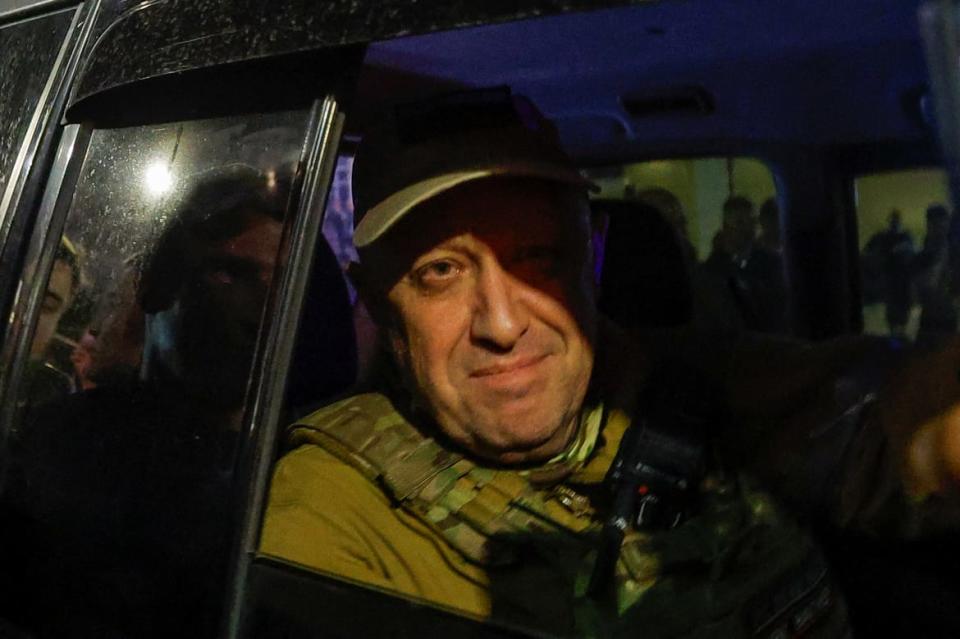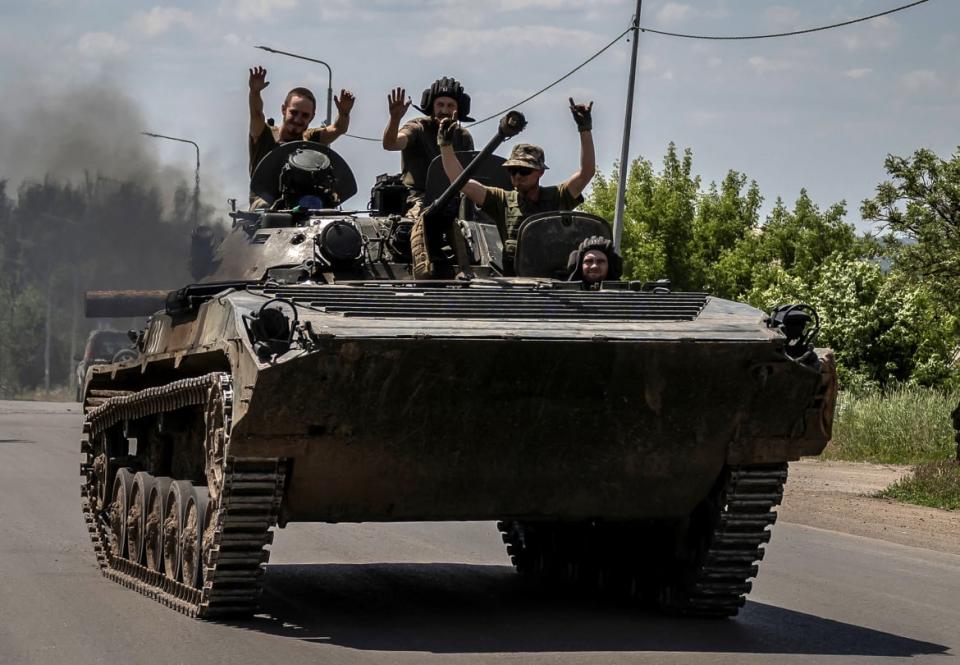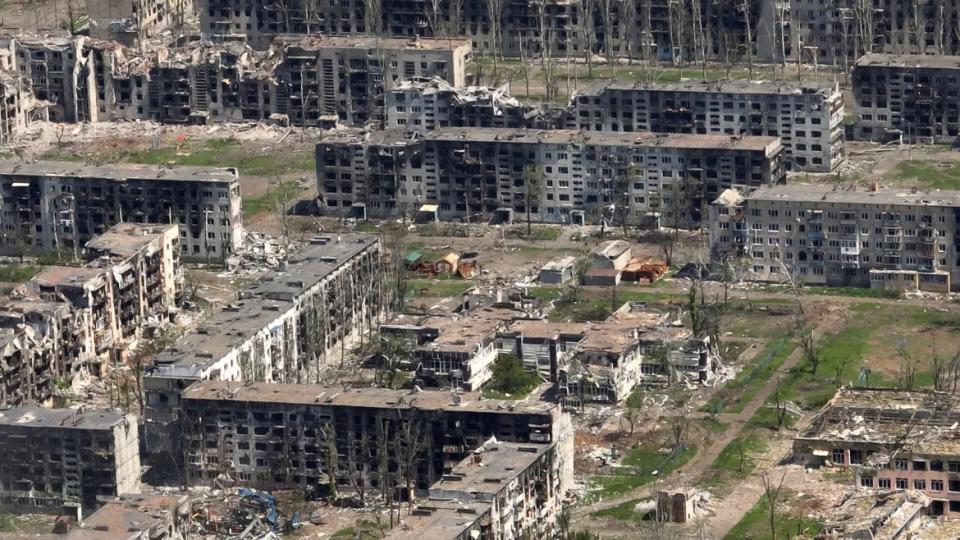Russia’s Mutiny Shows Ukraine Can Win the War

- Oops!Something went wrong.Please try again later.
- Oops!Something went wrong.Please try again later.
The immediate crisis in Russia is over, as Wagner PMC leader Yevgeny Prigozhin stopped his armed mutiny after two days, with little to show for it. But the cracks in Russia the revolt revealed—and will further stress—show how Ukraine’s strategy can ultimately succeed.
Ukraine just needs the Russian government to change its mind and accept Ukrainian independence. That’s much easier said than done. But it doesn’t require total battlefield victory, nor for Vladimir Putin to fall (though that could do the trick).
While the mutiny didn’t turn into a coup attempt or civil war, as some observers rushed to declare, it did highlight the sort of growing internal divisions that could eventually end the conflict. That provides some validation for earlier Ukrainian gambles aimed at heightening those divisions, most notably in Bakhmut, and indicates that successes in Ukraine’s counteroffensive this year would add further stress.
Ukraine Will Be the Big Winner of Prigozhin Turning On Putin
The best thing outsiders can do to end the war—not only a temporary pause to combat, but a just peace that lasts—is to support Ukraine’s self-defense, while pressuring Russia to negotiate.
How Many Divisions?
Because Russia is engaged in a war of choice, trying to subjugate a smaller neighbor, it does not face an existential threat from foreign invasion, and can stop at any time. Enough domestic disunity and dissent, fueled by frustration with the war effort, could reorder Putin’s calculus or facilitate a factional shift and leave Russia looking to cut a deal.
Wagner’s mutiny makes that look increasingly plausible, highlighting this division, and showing Russian elites Putin may be weaker than he seemed. Suspicion alone creates complications for Russia’s leader, as it simultaneously encourages elites’ ambition to act in pursuit of their own interests, and raises fear that Putin’s weakness means they have no choice.
Reasserting the perception of control, as Putin attempted in an angry public statement on Monday declaring the revolt a failure, will be difficult as long as the war continues without decisive success.

Wagner mercenary chief Yevgeny Prigozhin leaves the headquarters of the Southern Military District amid the group's pullout from the city of Rostov-on-Don, Russia on June 24, 2023.
According to the Kremlin, Prigozhin is going to Belarus, and Wagner fighters who didn’t join the revolt will sign contracts with the Ministry of Defense (MoD). Who knows how that’ll go, considering that Defense Minister Sergei Shoigu ordered something similar on June 10, which was a main impetus for Wagner’s revolt two weeks later. And it’s not clear what’s next for mutineers, or for Wagner’s operations in Africa and the Middle East.
The government could crack down too hard, prompting more dissent. Or try to sweep the problem under the rug, do too little, and get surprised again. Even if it goes smoothly, and ends up with Wagner under tighter state control (or dissolved), the process will take up resources and attention that could’ve been spent on the war.
Roger Waters Is Not Helping to Bring Peace to Ukraine
Meanwhile, to the Russian military fighting in Ukraine, Wagner was already claiming more credit than it deserved, and has now undermined the war effort. The government handled the mutiny without pulling any units from the Ukrainian theater, but they reportedly lost six helicopters, the pilots, and more.
Those casualties and equipment losses did less damage to Russia’s war effort than reactions will. Leaders have another thing to worry about right as Ukraine attempts a counteroffensive. Russian personnel throughout the ranks likely heard about the mutiny and have opinions about it, which will impact morale.
Ukrainian Gambles
The explosion of Wagner-MoD tensions validates Ukraine’s contentious decision to contest the eastern Ukrainian city of Bakhmut. Ranked 58th by prewar population and without significant transport hubs, it holds little strategic value on its own. But Wagner made it a priority, with Prigozhin treating the battle as a showcase—in particular for the tactic of throwing waves of prisoners he recruited into a meat grinder, then sending experienced fighters after defenders tire and expend ammunition—hoping it would get him more control over the war from Shoigu and other Defense Ministry leaders.

Ukrainian service members ride a BMP-1 infantry fighting vehicle near the front line city of Bakhmut, Donetsk region, Ukraine on June 9, 2023.
At first, casualty ratios in Bakhmut heavily favored Ukraine, providing an opportunity for attrition ahead of this summer’s operations. But as Russia made grinding advances, casualty rates grew closer to even, and in March, Ukraine faced calls to abandon the husk of a city. But Ukrainian generals and President Volodymyr Zelensky continued prioritizing it, in part because of the symbolic importance Russia placed on it.
If Russia wins in Bakhmut, Zelesnky explained in a March 28 interview, Putin would “sell this victory to the West, to his society, to China, to Iran.” Three months later it looks like a good argument. After Ukrainian successes in Kharkiv and Kherson last year, denying Russia a win in 2023 likely helped maintain support for Ukraine in NATO countries, and discouraged support for Russia in China, which has hesitated to back a losing effort.
Contesting Bakhmut—making Russia pay high prices for small advances, and maintaining positions on the outskirts while keeping a supply road open even after Russia captured the city center—helped increase tensions between Wagner and the Ministry of Defense. Prigozhin publicly complained of ammunition shortages in March, April, and May, blaming MoD for under-supply (which may or may not have been true, and probably involved some element of domestic positioning and deflecting blame). That likely played a role in Shoigu’s June order for private forces to sign contracts with MoD, which in turn played a role in Wagner’s revolt.
Public Perception
The Russian government controls a lot of the media and internet, but ordinary Russians must realize that the supposed-to-be easy “special military operation” is still going, and impacting them. Recruitment, conscription, stories from troops who come back, the holes left by those who don’t, public expressions of nationalism, and crackdowns on protesters can’t be all hidden or spun. Not entirely.
Putin Projects Nothing but Weakness
Similarly, the Wagner mutiny was too big and sudden to keep it from the Russian people. Rumors swirled online, the government blocked some news, social media, and messaging sites, and prevented online searches for Prigozhin. Two days later, Putin gave a televised address denouncing the revolt as attempted blackmail. The public knows something went wrong.
However, while the mutiny is the largest, most apparent crack in the Putin government’s image of ubiquitous control, it isn’t the first this year.
On May 22, a group of Russian dissidents burst across the Ukrainian border into Russia’s Belgorod region, making it unexpectedly far on roads and into towns. It took Russian forces over a day to reestablish control, and there were casualties on both sides.
Contrarian Defenses of RFK Jr. Are Not Brave—They’re Boring
The dissident group had some American military vehicles, and was likely encouraged by Ukrainian operatives. It’s also led by a neo-Nazi. This raised concerns that the association would jeopardize international support for Ukraine. But the counteroffensive, and now the Wagner mutiny, have overtaken it in the news, minimizing the damage to perceptions of Ukraine among its Western supporters, while the damage to internal perceptions of Russian state competence appears greater.
On May 3, two explosive-laden drones flew close to the Kremlin and got shot down. At the end of the same month, a group of drones hit residential areas of Moscow. Air defenses shot down some, and they killed no one, but a few hit apartment buildings. Like the Belgorod cross-border raid, both drone attacks were likely sponsored or at least encouraged by Ukranian intelligence.

Aerial view shows destroyed buildings as a result of intense fighting, amid the Russian invasion, in Bakhmut, Ukraine in this still image from handout video released June 15, 2023.
While there have been some small drone attacks in Russia near the border, these were the first in the capital. Again, some feared Ukraine over-reached. But the attacks contributed to perceptions that Putin isn’t fully in control, and that the war has costs for Russians, without any apparent downside for Ukraine.
Russia has been deliberately bombing residential buildings and civilian infrastructure in Ukraine on a regular basis since early last fall, so threats to retaliate mean little. Reduced damage to Ukrainian cities has come from deploying advanced Western air defense systems, not refraining from attacks in Russia that cause more embarrassment than physical damage.
A Path to Peace
Anyone who would like to see peace in Ukraine needs to recognize that the war will continue until Russia decides to stop.
That can come about in two ways:
The Ukrainians offer large enough concessions, such as swaths of land and the right to decide their own foreign relations, that the Kremlin takes the victory without achieving its original aim of controlling Kyiv (which they may try for again later).
The Ukrainians put up successful enough resistance that domestic pressures build in Russia to the point the Kremlin decides the costs of continuing the war outweigh the costs of taking the loss (which they can try to spin as a moral victory, and/or use to stoke grievances against the West).
There is no magic peace button for outside parties to press. Figures such as Indian Prime Minister Narendra Modi calling for “dialogue and diplomacy,” or Brazilian President Lula da Silva promising to “bring both of them to the table,” offer no plan to get Russia to stop.
Elon Musk’s Ukraine ‘Peace Plan’ Is Asinine
“Peace plans,” with proponents ranging from the government of China to wealthy tech investors, may describe hypothetically plausible end-states, but handwave the difficult part of getting the combatants to accept it.
Russia and Ukraine are the ones in the war, and no one else can end it. They’ll keep fighting as long as they have incompatible goals—Russia wants to control at least part of Ukraine; Ukraine wants independence and all its land back—and neither knows what they can force the other to accept. In that way, combat is part of negotiation, with battlefield results reshaping combatants’ demands.
Ukraine already got Russia to reduce its goal from controlling the whole country via the capital, to the whole Black Sea coast, to the areas it “annexed” with sham referendums last September, to the subset of that behind its current defensive lines. The counteroffensive aims to break through those lines, and force Russia to revise down again.
Whether it succeeds or fails, and to what degree, will unfold over months. But the Wagner mutiny improves the counteroffensive’s odds, at least a little, and adds to the ways Ukrainian success on the battlefield would exacerbate divisions within Russia.
The war is in large part a contest of will, and Russia’s just wobbled. With continued support from the U.S. and other partners, Ukraine can last long enough, and impose enough costs, that Russia will, however reluctantly, back off.
Get the Daily Beast's biggest scoops and scandals delivered right to your inbox. Sign up now.
Stay informed and gain unlimited access to the Daily Beast's unmatched reporting. Subscribe now.

